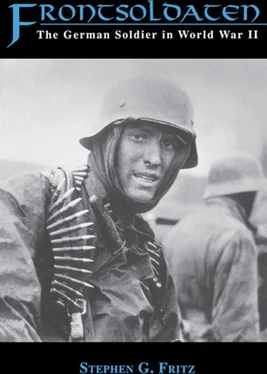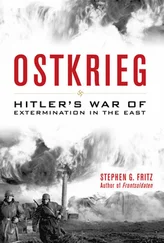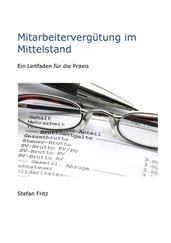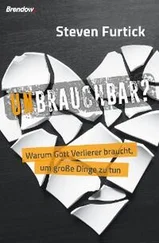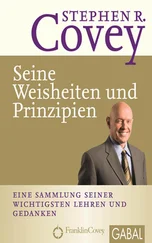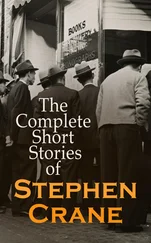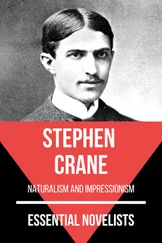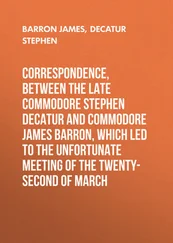Wer des Lichts begehrt, muß ins Dunkel gehn;
Was das Grauen mehrt, läßt das Heil entstehn.
Wo kein Sinn mehr mißt, waltet erst der Sinn;
Wo kein Weg mehr ist, ist des Wegs Beginn.
50. Holmes, Firing Line, pp. 74–79; letter of Harry Mielert (5 May 1943), in Mielert-Pflugradt, Russische Erde, p. 77.
51. Pöppel, Heaven and Hell, pp. 202, 218.
52. Letter of Gottfried Gruner (13 June 1943), in Bähr and Bähr, Kriegsbriefe, p. 280; Woltersdorf, Gods of War, p. 98.
53. Letter of Helmut Kniepkamp (12/13 Feb. 1944), in Bähr and Bähr, Kriegsbriefe, pp. 300–301.
54. Letters of anonymous soldier (22 Aug. and 31 Oct. 1941), in Dollwet, “Menschen im Krieg,” p. 307; letter of Lieutenant W.T. (1 Feb. 1943), in Buchbender and Sterz, Andere Gesicht, p. 112 no. 200.
55. Letter of Helmut Vethake (13 June 1943), in Bähr and Bähr, Kriegsbriefe, p. 238; letter of Karl Fuchs (26 Oct. 1941), in Richardson, Sieg Heil!, pp. 147–148.
56. Letter of anonymous soldier (29 Sept. 1943), in Dollwet, “Menschen im Krieg,” p. 303; Grupe, Jahrgang 1916, p. 266.
57. Letters of Paul Kaysel (23 Feb. 1940), Eberhard Wendebourg (5 Oct. 1941) and Bernhard Beckering (10 Dec. 1944), in Bähr and Bähr, Kriegsbriefe, pp. 131–32, 106, 430; Pöppel, Heaven and Hell, p. 157; Berghahn, “Meinungsforschung im ‘Dritten Reich,’” pp. 83–119.
58. Rempel, Hitler’s Children, p. 249; Maschmann, Account Rendered, pp. 168–69; Grupe, Jahrgang 1916, p. 340; Sajer, Forgotten Soldier, p. 113.
59. Hansmann, Vorüber—nicht vorbei, pp. 140–41.
60. Ibid., pp. 143–44.
60. Sajer, Forgotten Soldier, pp. 461–63.
Chapter 8. Trying to Change the World
1. Harsch quoted in Horne, To Lose a Battle, p. 126; Watt, How War Came, p. 535; Shirer, Berlin Diary, pp. 198–201.
2. Baird, To Die for Germany, p. xii; Eksteins, Rites of Spring, pp. 211, 223, 325; Hüppauf, “Langemarck,” pp. 84–96; Herf, Reactionary Modernism, pp. 2, 30; Mann, Diaries, pp. 23, 25, 47–48, 129–30, 137, 148, 169.
3. Ernst Jünger, “Die Geburt des Nationalismus aus dem Krieg,” Deutsches Volkstum 11 (1929): 478; Jünger, Der Kampf, pp. 22, 33, 38, 89; Herf, Reactionary Modernism, pp. 70–76, 92; letter of Horstmar Seitz (31 Oct. 1942), in Bähr and Bähr, Kriegsbriefe, p. 285.
4. Jünger, “Totale Mobilmachung,” pp. 126–30; Jünger, Der Kampf, pp. 24–25; Jünger, Das Wäldchen, pp. 54–55; Starve, Elites against Democracy, pp. 392, 407; Herf, Reactionary Modernism, pp. 93, 104–5, 107; Hüppauf, “Langemarck,” pp. 84–85, 89–90, 93, 96; letter of Sebastian Mendelssohn-Bartholdy (27 Nov. 1944), in Bähr and Bähr, Kriegsbriefe, pp. 394.
5. Jünger, Der Arbeiter, p. 119; Starve, Elites against Democracy, pp. 392, 407; Herf, Reactionary Modernism, pp. 93, 104–5, 107; Hüppauf, “Langemarck,” pp. 84–85, 89–90, 93, 96; letters of Harry Mielert (7 March and 6 Dec. 1943), in Mielert-Pflugradt, Russische Erde, pp. 58, 114; letter of Ansgar Bollweg (Nov. 1943), in Bähr and Bähr, Kriegsbriefe, p. 302; letter of Karl Fuchs (28 June 1941), in Richardson, Sieg Heil! p. 116.
6. Ernst Jünger, “Über die Gefahr,” Widerstand 3 (1931): 67; Jünger, Der Arbeiter, p. 147; Herf, Reactionary Modernism, pp. 91,98, 105; letter of Corporal H.B. (27 Dec. 1942), in Buchbender and Sterz, Andere Gesicht, p. 100 no. 170; letter of Sebastian Mendelssohn-Bartholdy (Oct. 1944), in Bähr and Bähr, Kriegsbriefe, p. 391. Writing from Poland (7 April 1941, in Bähr and Bähr, Kriegsbrief, p. 39) Ital Gelzer confessed that his “most admired model in our times is Ernst Jünger.”
7. Jünger, “Totale Mobilmachung,” p. 120; Jünger, Der Arbeiter, p. 81; Herf, Reactionary Modernism, pp. 94, 103; letter of Reinhard Goes (23 Nov. 1941), in Bähr and Bähr, Kriegsbriefe, p. 457; Ernst Jünger, “Die Grundlagen des Nationalismus,” in Stahlhelm Jahrbuch 1927, ed. Franz Schauwecker (Magdeburg, 1927), p. 77; letter of Heinz Küchler (3 Sept. 1939) in Bähr and Bähr, Kriegsbriefe, p. 157; Ernst Jünger, “Die Abruster,” Arminius 8 (1927): 6; Herf, Reactionary Modernism, p. 97.
8. Letter of Gerhard Meyer (23 July 1941), in Bähr and Bähr, Kriegsbriefe, pp. 209–10; letters of Corporal E.K. (19 Sept. 1941) and Corporal E.K. (no relation); (21 Nov. 1941), in Buchbender and Sterz, Andere Gesicht, pp. 80 no. 124, 87 no. 145; diary entries of anonymous soldier (Dec. 1941) and of chaplain of Eighteenth Panzer Division, quoted in Bartov, The Eastern Front, pp. 33, 20.
9. Letter of Sergeant W. H. (30 Jan. 1942), in Buchbender and Sterz, Andere Gesicht, p. 92 no. 155; chaplain’s letter quoted in Bartov, Hitler’s Army, p. 46; letters of Martin Lindner (15 Sept. and 28 Nov. 1942), in Bähr and Bähr, Kriegsbriefe, pp. 170, 172.
10. Letter of Friedrich Reinhold Haag (12 July 1942), in Bähr and Bähr, Kriegsbriefe, p. 211; Prüller, Diary, p. 143.
11. Letters of Horstmar Seitz (19 July 1942) and Helmut Pabst (29 March 1942), in Bähr and Bähr, Kriegsbriefe, pp. 283, 248; letter of Corporal F.B. (24 Jan. 1943), in Buchbender and Sterz, Andere Gesicht, p. 151 no. 304; letter of Harry Mielert (1 Dec. 1943), in Mielert-Pflugradt, Russische Erde, p. 111.
12. Letters of Siegfried Roemer (27/28 March 1944), Hans Pietzcker (24 Dec. 1941), Will Thomas (19 Jan. 1942), Horstmar Seitz (9 Sept. 1942), and Helmut Pabst (20 Jan. 1943), in Bähr and Bähr, Kriegsbriefe, pp. 328, 213, 100, 284, 255.
13. Letters of Harald Henry (18 Aug. and 21 Oct. 1941), in Bähr and Bähr, Kriegsbriefe, pp. 74, 83–84.
14. Letter of Hans-Heinrich Ludwig (18/21 Oct. 1941), in Bähr and Bähr, Kriegsbriefe, p. 67; letters of Harry Mielert (7 Feb. and 19 Sept. 1943), in Mielert-Pflugradt, Russische Erde, pp. 52, 98; letters of Harald Henry (10 Sept. 1941) and Hans-Friedrich Stäcker (21 July 1940), in Bähr and Bähr, Kriegsbriefe, pp. 76,32. Jünger wrote that World War I was “the father of all things … [and] our father as well. It hammered, chiseled, and hardened us into what we are.” Jünger, Der Kampf, p. 13. He also acknowledged: “I have never had so carefree a life as at the front.” Jünger, Das Wäldchen, p. 6.
15. Letters of Wolfgang Kluge (3 and 5 Oct. 1943), Siegfried Roemer (9 Dec. 1943), Siegbert Stehmann (16 Nov. 1941) and Heinz Küchler (3 June 1940,11 July 1941), in Bähr and Bähr, Kriegsbriefe, pp. 288, 333, 416, 157, 159–60.
16. Signal magazine quoted in Laffin, Jackboot, p. 142. For further explication of the Nazi fascination with the new man as a product of World War I, the myth of sacrifice, and the redemptive power of youth, see Baird, To Die for Germany.
17. Grupe, Jahrgang 1916, p. 246; Woltersdorf, Gods of War, p. 170.
18. Letters of Corporal A.N. (23 June 1941), Private H.K. (n.d., probably Sept. 1941), and Corporal K.G. (18 July 1942), in Buchbender and Sterz, Andere Gesicht, pp. 71–72 no. 98, 81 no. 127, 171 no. 351.
19. Letter of Private F. (3 July 1941), in Buchbender and Sterz, Andere Gesicht, pp. 72–73 no. 101; letter of anonymous soldier, quoted in Dollwet, “Menschen im Krieg,” p. 298.
Читать дальше
